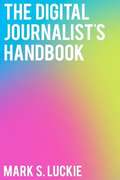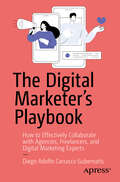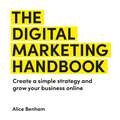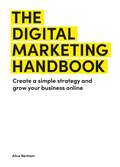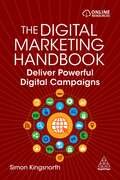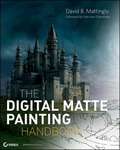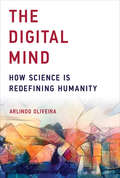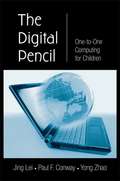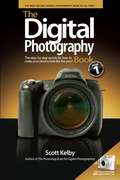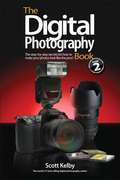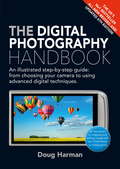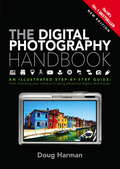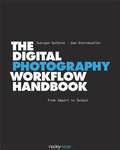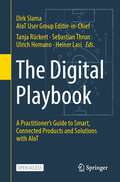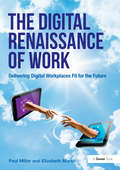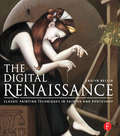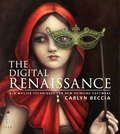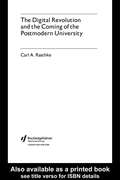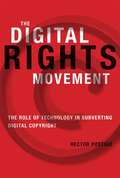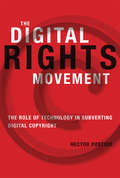- Table View
- List View
The Digital Is Kid Stuff: Making Creative Laborers for a Precarious Economy
by Josef NguyenHow popular debates about the so-called digital generation mediate anxieties about labor and life in twenty-first-century America &“The children are our future&” goes the adage, a proclamation that simultaneously declares both anxiety as well as hope about youth as the next generation. In The Digital Is Kid Stuff, Josef Nguyen interrogates this ambivalence within discussions about today&’s &“digital generation&” and the future of creativity, an ambivalence that toggles between the techno-pessimism that warns against the harm to children of too much screen time and a techno-utopianism that foresees these &“digital natives&” leading the way to innovation, economic growth, increased democratization, and national prosperity. Nguyen engages cultural histories of childhood, youth, and creativity through chapters that are each anchored to a particular digital media object or practice. Nguyen narrates the developmental arc of a future creative laborer: from a young kid playing the island fictions of Minecraft, to an older child learning do-it-yourself skills while reading Make magazine, to a teenager posting selfies on Instagram, to a young adult creative laborer imagining technological innovations using design fiction. Focusing on the constructions and valorizations of creativity, entrepreneurialism, and technological savvy, Nguyen argues that contemporary culture operates to assuage profound anxieties about—and to defuse valid critiques of—both emerging digital technologies and the precarity of employment for &“creative laborers&” in twenty-first-century neoliberal America.
The Digital Journalist's Handbook
by Mark S. LuckieThe Digital Journalist's Handbook is your guide to the tools you need to know to thrive in today's digital newsroom. This unique how-to book provides simple explanations of complex technologies and provides examples of how journalists can incorporate them into their stories and reporting. The Handbook is composed of 12 chapters, each dedicated to a different tool in the digital journalist's toolbox. Chapters include "Writing for the Web," "Blogging," "Photography," "Audio," "Audio Slideshows," "Video," "Web Design," "Social Networking," "Data Visualization," and "Flash," as well as a glossary with definitions of more than 130 technical terms and phrases commonly used in digital journalism. The Handbook is also fully illustrated and contains diagrams and guidelines of everything from the layout of a typical blog to the features found on a digital audio recorder. In addition, each chapter includes links to online resources, tutorials, and examples of every technology mentioned in the book. The Digital Journalist's Handbook is a must-read for both novice digital journalists and tech-savvy experts.
The Digital Literary Sphere: Reading, Writing, and Selling Books in the Internet Era
by Simone MurrayHow has the Internet changed literary culture?2nd Place, N. Katherine Hayles Award for Criticism of Electronic Literature by The Electronic Literature OrganizationReports of the book’s death have been greatly exaggerated. Books are flourishing in the Internet era—widely discussed and reviewed in online readers’ forums and publicized through book trailers and author blog tours. But over the past twenty-five years, digital media platforms have undeniably transformed book culture. Since Amazon’s founding in 1994, the whole way in which books are created, marketed, publicized, sold, reviewed, showcased, consumed, and commented upon has changed dramatically. The digital literary sphere is no mere appendage to the world of print—it is where literary reputations are made, movements are born, and readers passionately engage with their favorite works and authors.In The Digital Literary Sphere, Simone Murray considers the contemporary book world from multiple viewpoints. By examining reader engagement with the online personas of Margaret Atwood, John Green, Gary Shteyngart, David Foster Wallace, Karl Ove Knausgaard, and even Jonathan Franzen, among others, Murray reveals the dynamic interrelationship of print and digital technologies. Drawing on approaches from literary studies, media and cultural studies, book history, cultural policy, and the digital humanities, this book asks: What is the significance of authors communicating directly to readers via social media? How does digital media reframe the "live" author-reader encounter? And does the growing army of reader-reviewers signal an overdue democratizing of literary culture or the atomizing of cultural authority? In exploring these questions, The Digital Literary Sphere takes stock of epochal changes in the book industry while probing books’ and digital media’s complex contemporary coexistence.
The Digital Marketer's Playbook: How to Effectively Collaborate with Agencies, Freelancers, and Digital Marketing Experts
by Diego Adolfo Carrasco GubernatisTransition from traditional marketing to digital marketing and master a comprehensive range of topics within this field. This book offers a practical, step-by-step approach to managing digital marketing (with the help of experts) in the current landscape, making it a timely and valuable resource for marketers, business owners, and students alike. With an emphasis on referential information, you’ll review some of the foundational concepts of digital marketing, including digital assets, advertising channels, formats, and customer awareness. You’ll also delve into targeting methods, audience segmentation, and the use of keywords for display and search ads. Gain insights into key digital marketing metrics like CPC, CPV, CPM, clicks, and CTR, and how they impact campaign performance. Learn about conversion tracking, analytics, and how to interpret digital marketing reports to evaluate campaign success. Explore advanced topics such as the use of artificial intelligence in digital marketing for targeting and content optimization. Understand the landscape of legal, tax, and brand protection in the digital space. The book's relevance stems from the increasing dominance of digital channels in marketing. In today's digital age, understanding and effectively utilizing digital marketing strategies is not just important but essential for businesses and marketers. The shift towards digital has been accelerated by technological advancements and changes in consumer behavior, making digital marketing skills more critical than ever, but not every executive and marketing professional has managed to stay on top of its developments. The Digital Marketer's Playbook is an essential guide for those who have foundational knowledge in marketing but are relatively new to the domain of digital marketing. What You Will Learn See how a digital marketing campaign works (across providers, not provider-specific). Implement campaign optimizations. Explore digital marketing channels, creatives, formats, and advertiser channel providers. Review the wording (jargon) used in the industry (personas, target group, bids, keywords, etc.). Who This Book is For Those who have implemented marketing campaigns, but they are looking to dive deeper into digital marketing, understand it’s particularities and know what to ask for and what to expect from specialists.
The Digital Marketing Handbook: Create a simple strategy and grow your business online
by Alice BenhamGet clarity and take action to grow your business using digital mediaThere's so much marketing expertise out there but how should people know what to listen to? How to implement it? Or where to start? By covering the fundamentals of marketing, this audiobook will act as a north star for small business owners looking to grow. Like Alice herself, the book is honest, practical, engaging and actionable - no fluff or complication allowed - and will help you build a community, get visible and make sales. It is rooted in theory but with real-life experiences, and will leave you with the clarity and systems to take your business to the next level.(P) 2024 Quercus Editions Limited
The Digital Marketing Handbook: Create a simple strategy and grow your business online
by Alice BenhamFrom strategist, speaker and podcaster Alice Benham comes The Digital Marketing Handbook - an expert guide covering the fundamentals of marketing, filled with case studies and interviews with industry insiders.There's so much marketing expertise out there but how should people know what to listen to? How to implement it? Or where to start? By covering the fundamentals of marketing, this book will act as a north star for small business owners looking to grow. Like Alice herself, the book is honest, practical, engaging and actionable - no fluff or complication allowed - and will help you build a community, get visible and make sales. Rooted in theory but with real-life experiences and case studies from entrepreneurs who have made digital marketing work for them, the book will leave you with the clarity and systems to take your business to the next level. An indispensable resource for small business owners, freelancers, entrepreneurs and marketing students.Here's what to expect from the book:Proven and practical expertise Clear definitions (no jargon!) Quick tips Examples and case studies Insights from trusted experts Chapter summaries for easy reminders Action steps for every topic
The Digital Marketing Handbook: Create a simple strategy and grow your business online
by Alice BenhamFrom strategist, speaker and podcaster Alice Benham comes The Digital Marketing Handbook - an expert guide covering the fundamentals of marketing, filled with case studies and interviews with industry insiders.There's so much marketing expertise out there but how should people know what to listen to? How to implement it? Or where to start? By covering the fundamentals of marketing, this book will act as a north star for small business owners looking to grow. Like Alice herself, the book is honest, practical, engaging and actionable - no fluff or complication allowed - and will help you build a community, get visible and make sales. Rooted in theory but with real-life experiences and case studies from entrepreneurs who have made digital marketing work for them, the book will leave you with the clarity and systems to take your business to the next level. An indispensable resource for small business owners, freelancers, entrepreneurs and marketing students.Here's what to expect from the book:Proven and practical expertise Clear definitions (no jargon!) Quick tips Examples and case studies Insights from trusted experts Chapter summaries for easy reminders Action steps for every topic
The Digital Marketing Handbook: Deliver Powerful Digital Campaigns
by Simon KingsnorthBuild, implement and optimize your digital marketing campaigns, with this indispensable guide which covers everything from SEO, social media, paid search and display advertising. The Digital Marketing Handbook takes the reader step by step through the various components of B2B and B2C online marketing, making it an essential companion to every marketer's desk. Highly practical in approach, it features tips, platform recommendations and common pitfalls to watch out for, as well as examples from global brands including Google, Amazon and Nissan. Detailed guidance is provided for key areas such as creating content that excites, informs and converts, using marketing automation and analyzing your results to maximize performance. Written by recognized industry expert and bestselling author, Simon Kingsnorth, The Digital Marketing Handbook brings together reliable and actionable insights into one complete resource. Also covering how to manage affiliates and partnerships to deliver highly targeted leads and provide customer service that achieves high review scores and builds loyalty, it is accompanied by online templates and interactive tools to use in practice. This book is an essential blueprint for marketing professionals to deliver the best results from their digital marketing campaigns.
The Digital Matte Painting Handbook
by David B. MattinglyThe only how-to guide dedicated to mastering the technique of digital matte painting! Matte painting affords seamless integration between an artist's painting with live action film footage and allows for greater flexibility and creative input in the appearance of movie settings. This unique book reveals a variety of tools and techniques that are both industry and classroom tested and will enhance your existing skill set. Veteran author and instructor David Mattingly walks you through the process of creating a matte painting, starting with rough concept sketches, working out the perspective drawing, adding light and shadow, and texturing all of the elements in the painting. You'll gradually upgrade to using Adobe After Effects and Autodesk Maya in order to fulfill your matte painting vision. Escorts you through the process of creating a matte painting, starting with the initial concept sketch, adding light and shadow, texturing elements, and incorporating motion and depth Author is an experienced matte artist and teacher and shares a plethora of unique industry- and classroom-tested tools and techniques Features helpful step-by-step instructions accompanied by screen shots and photos to illustrate the process of creating a matte painting Whether you're creating a background for a studio production, independent film, TV commercial, or YouTube video, The Digital Matte Painting Handbook helps you successfully complete your project. Note: CD-ROM/DVD and other supplementary materials are not included as part of eBook file.
The Digital Mind: How Science Is Redefining Humanity (The\mit Press Ser.)
by Arlindo OliveiraHow developments in science and technology may enable the emergence of purely digital minds—intelligent machines equal to or greater in power than the human brain.What do computers, cells, and brains have in common? Computers are electronic devices designed by humans; cells are biological entities crafted by evolution; brains are the containers and creators of our minds. But all are, in one way or another, information-processing devices. The power of the human brain is, so far, unequaled by any existing machine or known living being. Over eons of evolution, the brain has enabled us to develop tools and technology to make our lives easier. Our brains have even allowed us to develop computers that are almost as powerful as the human brain itself. In this book, Arlindo Oliveira describes how advances in science and technology could enable us to create digital minds. Exponential growth is a pattern built deep into the scheme of life, but technological change now promises to outstrip even evolutionary change. Oliveira describes technological and scientific advances that range from the discovery of laws that control the behavior of the electromagnetic fields to the development of computers. He calls natural selection the ultimate algorithm, discusses genetics and the evolution of the central nervous system, and describes the role that computer imaging has played in understanding and modeling the brain. Having considered the behavior of the unique system that creates a mind, he turns to an unavoidable question: Is the human brain the only system that can host a mind? If digital minds come into existence—and, Oliveira says, it is difficult to argue that they will not—what are the social, legal, and ethical implications? Will digital minds be our partners, or our rivals?
The Digital Pencil: One-to-One Computing for Children
by Jing LeiThis book takes a serious historical and international look at the "digital pencil" movement to equip every student with a computing device with wireless connection. Using an ecological perspective as an overarching framework, and drawing on their own studies and available literature that illuminate the issues related to one-to-one computing, the a
The Digital Photographer's Guide to Light Modifiers
by Allison EarnestFocusing exclusively on light modifiers and making the most of the least equipment, this in-depth handbook is ideal for use by the beginner and advanced amateurs who wish to take their photography to the next level. Including diagrams and lighting set scenes to facilitate learning and adapting technique, step-by-step critiques of several portrait sessions, and an extensive review of a variety of light modifying tools-from barn doors and snoots to gels, umbrellas, and strip boxes-this invaluable textbook style book reveals the precise steps for obtaining dimension and depth for indoor and outdoor portrait sessions. This resource is a must-have for beginner photographers looking to discover a treasure trove of fresh, creative lighting inspiration, that will surely help add diversity and creative style to your photography
The Digital Photography Book, Volume 1: The Step-by-Step Secrets for How to Make Your Photos Look Like the Pros
by Scott KelbyThis text tackles the most important side of digital photography - how to take professional-quality shots using the same tricks today's top digital pros use.
The Digital Photography Book, Volume 2: The Step-by-Step Secrets for How to Make Your Photos Look Like the Pros
by Scott KelbyThis text tackles the most important side of digital photography - how to take professional-quality shots using the same tricks today's top digital pros.
The Digital Photography Handbook: An Illustrated Step-by-step Guide
by Doug HarmanNeed to know which digital camera to buy? Want to take better photographs and retouch images? Ready to achieve professional results? This updated edition of The Digital Photography Handbook will allow you to make the most of all the advantages your camera has to offer - as well as guiding you through the latest software to enhance your images, and get professional results with every shot. This book includes expert advice on the art of photography (composition, depth of field and how to photograph a variety of subjects), editing and image manipulation software, how to print your images for the best results, developing a portfolio and mastering the rules of copyright. Doug Harman includes the very latest developments in digital technology, equipping you with everything you need to become a photographer. Contents include: Types of camera, Computers and software, Memory, Pixels and magnification, Saving images, Exposure, Composition, Light, Camera modes, Special effects, Manipulating images, Photo apps, Retouching old photos, Printing digital images, Selecting printers and paper, Archiving and the cloud, Making money from your images, Copyright rules and more.
The Digital Photography Handbook: An Illustrated Step-by-step Guide
by Doug HarmanNeed to know which digital camera to buy? Want to take better photographs and retouch images? Ready to achieve professional results? This updated edition of The Digital Photography Handbook will allow you to make the most of all the advantages your camera has to offer - as well as guiding you through the latest software to enhance your images, and get professional results with every shot. This book includes expert advice on the art of photography (composition, depth of field and how to photograph a variety of subjects), editing and image manipulation software, how to print your images for the best results, developing a portfolio and mastering the rules of copyright. Doug Harman includes the very latest developments in digital technology, equipping you with everything you need to become a photographer. Contents include: Types of camera, Computers and software, Memory, Pixels and magnification, Saving images, Exposure, Composition, Light, Camera modes, Special effects, Manipulating images, Photo apps, Retouching old photos, Printing digital images, Selecting printers and paper, Archiving and the cloud, Making money from your images, Copyright rules and more.
The Digital Photography Workflow Handbook: From Import to Output
by Uwe Steinmueller Juergen Gulbins<p>The work that follows the capture of a photographic image - the workflow in the digital darkroom - has a significant effect on the quality of the final image. The Digital Photography Workflow Handbook will help you avoid crucial mistakes as you master the craft of photographic post-processing.<br/><br/>\nThis book provides a step-by-step guide through the photographic workflow, from image capture, editing, and asset management, all the way to the perfect photographic print. The workflow presented in this book focuses on RAW images and is based on two of the most popular and powerful software tools: Adobe Photoshop and Lightroom.<br/><br/>\nThe Digital Photography Workflow Handbook can be used as a reference or textbook by both aspiring amateur and professional photographers, as well as by students.</p>
The Digital Playbook: A Practitioner’s Guide to Smart, Connected Products and Solutions with AIoT
by Dirk Slama Sebastian Thrun Tanja Rückert Ulrich Homann Heiner LasiThis open access book is a practitioner's guide to smart, connected products and solutions. As a hands-on playbook, it combines the business and technical execution perspectives to help product companies, OEMs, manufacturers and equipment operators utilize the full potential of digital enablers, especially Artificial Intelligence (AI), Internet of Things (IoT) and Digital Twins. The Digital Playbook provides comprehensive and actionable guidance, helping to address the challenges of creating sustainable and scalable digital business models, managing cocreation and sourcing, setting up the digital organization, and handling the legal aspects. For the technical execution perspective, the playbook includes the AIoT Framework, which explains how to combine data science and AI engineering with Digital Twins, as well as software development for cloud and edge. The integration with physical product development and retrofit integration of existing equipment is included as well. A pragmatic, agile approach is introduced that takes common agile inhibitors into consideration. A holistic AIoT DevOps approach is described, which combines key elements of DevOps for cloud, edge and AI. Enterprise readiness is ensured by looking at trust and security as well as reliability and resilience for AIoT. A large number of real-world examples and case studies help ensure practical relevance. Readers should have a previous, general understanding of digital strategies and technologies. This book offers readers a clear understanding of the opportunities, as well as the challenges related to building and operating smart, connected products and solutions. They are given a set of tools and blueprints, which they can apply to their practical work in this space.
The Digital Renaissance of Work: Delivering Digital Workplaces Fit for the Future
by Paul Miller Elizabeth MarshThe world of work is going through an unprecedented revival driven by new technologies. The Digital Renaissance of Work: Delivering Digital Workplaces Fit for the Future will take the reader on a journey into the emerging technology-led revival of work. A unique combination of thought leadership and technical know-how, this book will bring the reader up-to-date with the latest developments in the field, such as: freelancing the organisation/ work but no jobs, localisation/ work but not place, time travel and death of the weekend, trust, privacy and the quantified employee, leadership in the hyper connected organisation, beyond the office/ the mobile frontline, automation and the frontiers of work, as well as setting out how to lay down the roadmap for the digital workplace: the human centred digital workplace, making the business case, setting up the digital workplace programme, technology deployment, measuring the digital workplace. The book will draw on new case studies from major organisations with which Paul Miller is in regular discussion, such as: Accenture - aligning the digital and physical workplaces; Barclays - innovating in a regulated environment; Deutsche Post/ DHL - leading at the mobile frontline; Environment Agency - real time collaboration; IBM - pushing the digital workplace frontiers; IKEA - measuring the digital workplace; SAP - gamifying the enterprise. Paul Miller’s follow up to his critically acclaimed The Digital Workplace picks up the story to provide organisations with an understanding of the structural and organizational implications the emerging technology has for the workplace. His insights, backed by the considerable research of the Digital Workplace Forum, offer a lifeline to organizations needing to make better sense of a very uncertain future.
The Digital Renaissance: Classic Painting Techniques in Photoshop and Painter
by Carlyn BecciaPlease note: the website printed in the book [carlynpaints.com] is no longer valid. Please find the author's dedicated book page at: http://www.carlynbeccia.com/carlynpaints/thedigitalrenaissance.html Also, the excercise downloads referred to in the book at: http://www.carlynbeccia.com/carlynpaints/downloads.html The Digital Renaissance teaches you how to translate the methods and skills found in traditional art to the digital medium. By covering fundamental painting principles and the basics of digital software, before moving into tutorials that break down key techniques, professional artist Carlyn Beccia teaches you how to use the tools at hand to paint your own works of art. Each chapter showcases one great painter and analyzes the techniques that set each one apart. These techniques are then imitated in step-by-step tutorials, allowing you to achieve amazingly convincing results and bring your own work to new creative heights.
The Digital Renaissance: Old-Master Techniques in Painter and Photoshop
by Carlyn BecciaThe Digital Renaissance teaches you how to translate the methods and skills found in traditional art to the digital medium. By covering fundamental painting principles and the basics of digital software, before moving into tutorials that break down key techniques, professional artist Carlyn Beccia encourages you to use the tools at hand to paint your own works of art. Each chapter showcases one great painter - the selection includes Michelangelo, Van Gogh, Sargent, Gustav Klimt, Matisse, and Picasso - and analyses the techniques that set each one apart. These techniques are then emulated in step-by-step tutorials, allowing today's digital artist to achieve amazing results in Corel Painter and Adobe Photoshop.
The Digital Revolution and the Coming of the Postmodern University
by Carl A. RaschkeIn recent years, the powerful social, cultural and economic changes wrought by digital technology have led many to forecast the end of the university as we know it. This book employs extensive research and case studies to explain why these predictions, even if perhaps somewhat premature, are on solid ground.The Digital Revolution and the Coming of the Postmodern University shows how the internet, high-speed electronic communications and personal computers necessitate a radical rethinking of what is meant by 'higher education'. The book calls into question both the traditionalist's scepticism about the benefits of new technology, and the corporate e-learning advocate's failure to grasp that education is more than what happens on a computer screen. The author provides concrete data and models for more democratic, restructured systems of instruction that not only take advantage of advanced learning technologies, but promote the globalisation of higher education.This is an essential read for anyone concerned about the future of higher education.
The Digital Rights Delusion: Humans, Machines and the Technology of Information
by Andrea MontiThis book examines the ever-increasing impact of technology on our lives and explores a range of legal and constitutional questions that this raises. It considers the extent to which concepts such as 'cyberspace' and 'digital rights' advance or undermine our understanding of this development and proposes a number of novel approaches to the effective protection of our rights in this rapidly evolving environment. Finally, it shows how the abuse of the adjective digital has demoted legal rights into subjective and individual claims. The work will be of particular interest to scholars of privacy, artificial intelligence and free speech, as well as policymakers and the general reader.
The Digital Rights Movement
by Hector PostigoThe movement against restrictive digital copyright protection arose largely in response to the excesses of the Digital Millennium Copyright Act (DMCA) of 1998. In The Digital Rights Movement, Hector Postigo shows that what began as an assertion of consumer rights to digital content has become something broader: a movement concerned not just with consumers and gadgets but with cultural ownership. Increasingly stringent laws and technological measures are more than incoveniences; they lock up access to our "cultural commons. " Postigo describes the legislative history of the DMCA and how policy "blind spots" produced a law at odds with existing and emerging consumer practices. Yet the DMCA established a political and legal rationale brought to bear on digital media, the Internet, and other new technologies. Drawing on social movement theory and science and technology studies, Postigo presents case studies of resistance to increased control over digital media, describing a host of tactics that range from hacking to lobbying. Postigo discusses the movement's new, user-centered conception of "fair use" that seeks to legitimize noncommercial personal and creative uses such as copying legitimately purchased content and remixing music and video tracks. He introduces the concept of technological resistance--when hackers and users design and deploy technologies that allows access to digital content despite technological protection mechanisms--as the flip side to the technological enforcement represented by digital copy protection and a crucial tactic for the movement.
The Digital Rights Movement: The Role of Technology in Subverting Digital Copyright (The Information Society Series)
by Hector PostigoThe evolution of activism against the expansion of copyright in the digital domain, with case studies of resistance including eBook and iTunes hacks.The movement against restrictive digital copyright protection arose largely in response to the excesses of the Digital Millennium Copyright Act (DMCA) of 1998. In The Digital Rights Movement, Hector Postigo shows that what began as an assertion of consumer rights to digital content has become something broader: a movement concerned not just with consumers and gadgets but with cultural ownership. Increasingly stringent laws and technological measures are more than incoveniences; they lock up access to our “cultural commons.”Postigo describes the legislative history of the DMCA and how policy “blind spots” produced a law at odds with existing and emerging consumer practices. Yet the DMCA established a political and legal rationale brought to bear on digital media, the Internet, and other new technologies. Drawing on social movement theory and science and technology studies, Postigo presents case studies of resistance to increased control over digital media, describing a host of tactics that range from hacking to lobbying.Postigo discusses the movement's new, user-centered conception of “fair use” that seeks to legitimize noncommercial personal and creative uses such as copying legitimately purchased content and remixing music and video tracks. He introduces the concept of technological resistance—when hackers and users design and deploy technologies that allows access to digital content despite technological protection mechanisms—as the flip side to the technological enforcement represented by digital copy protection and a crucial tactic for the movement.

